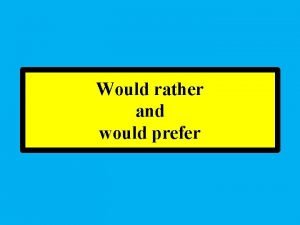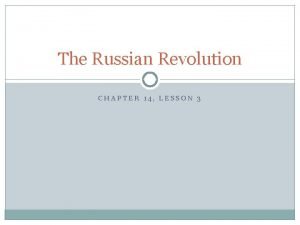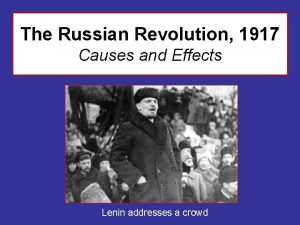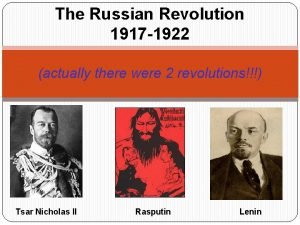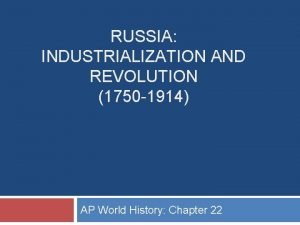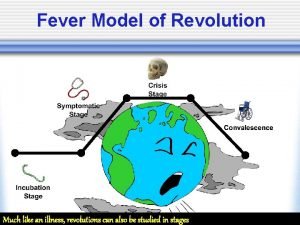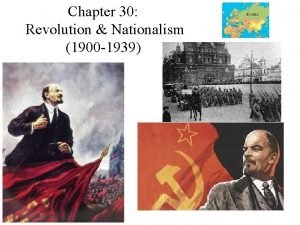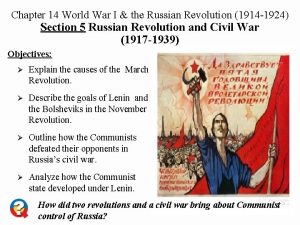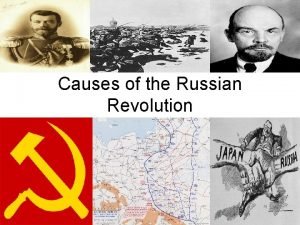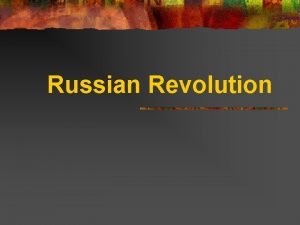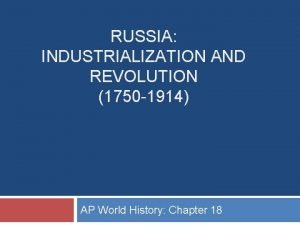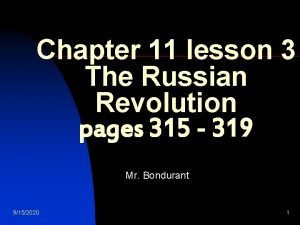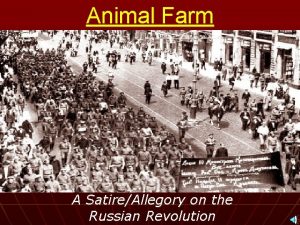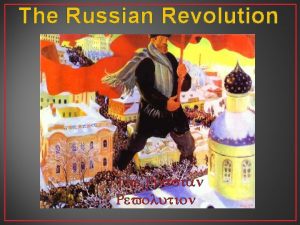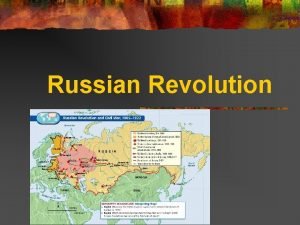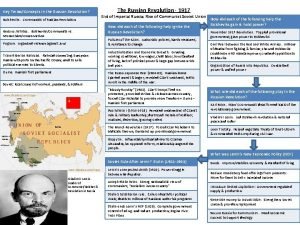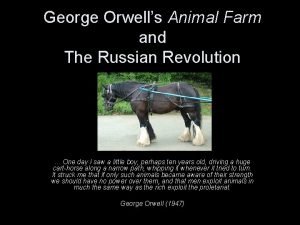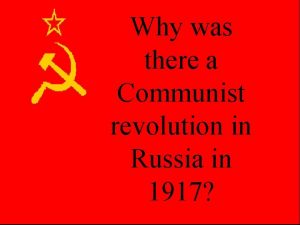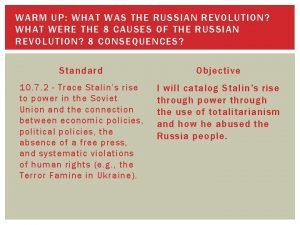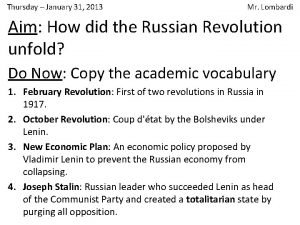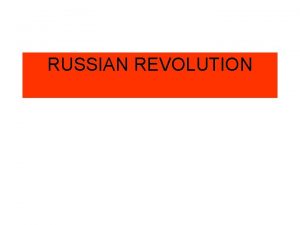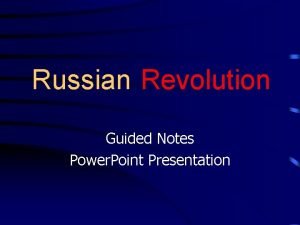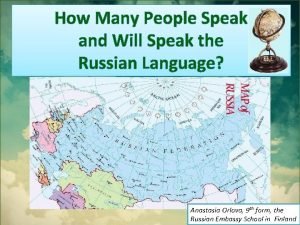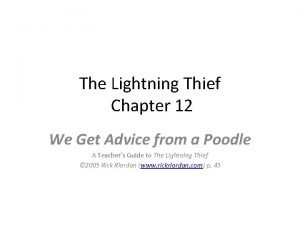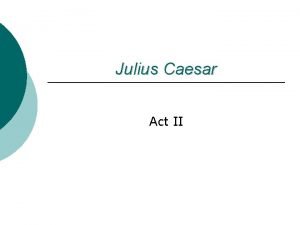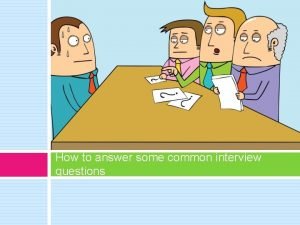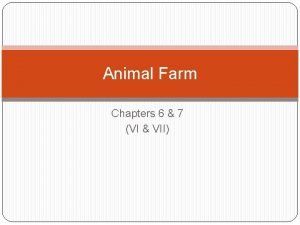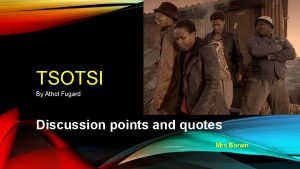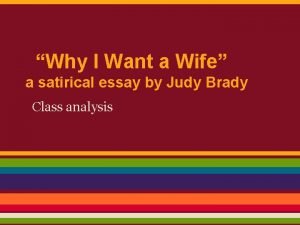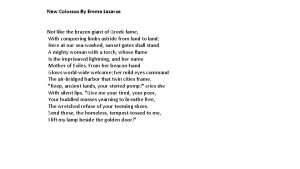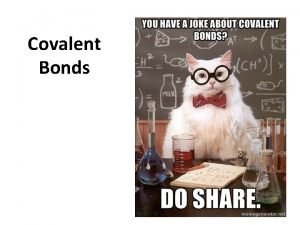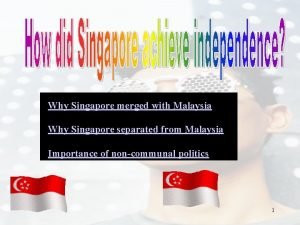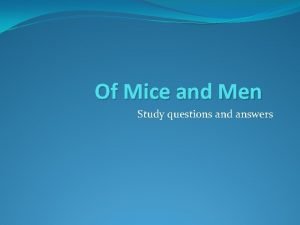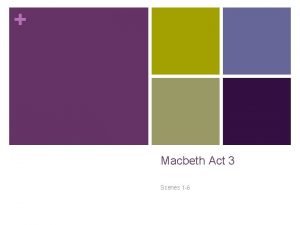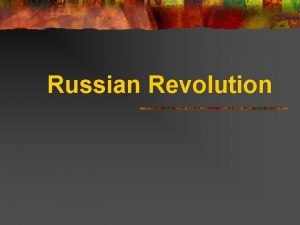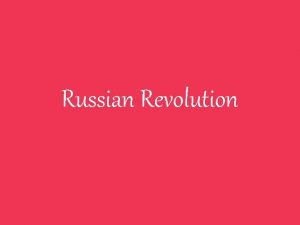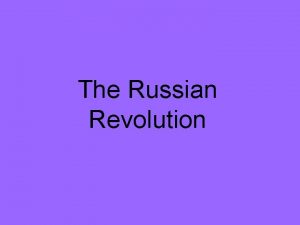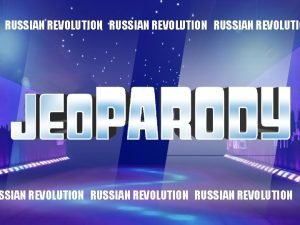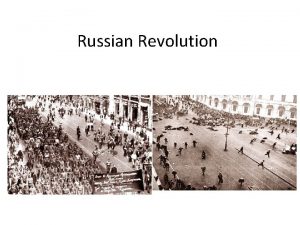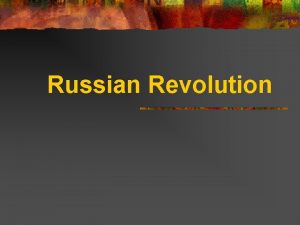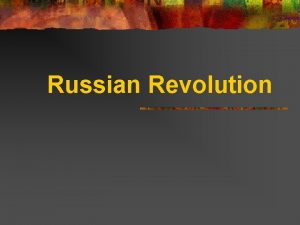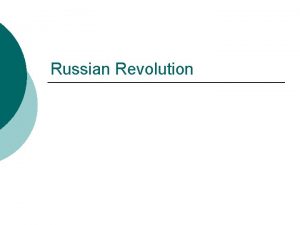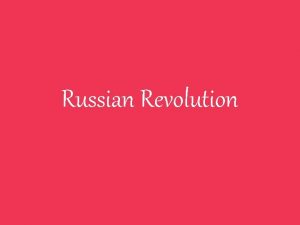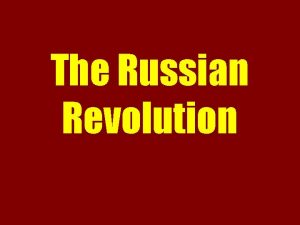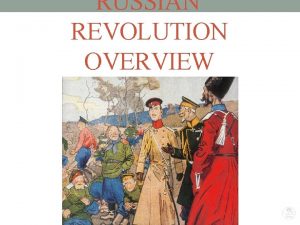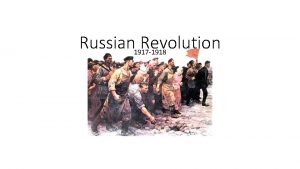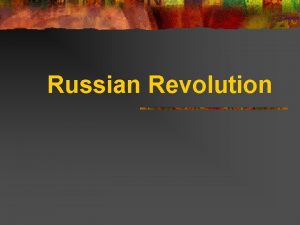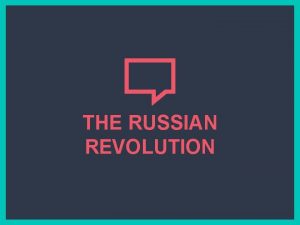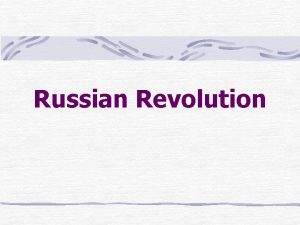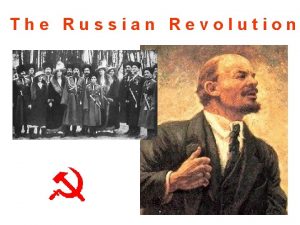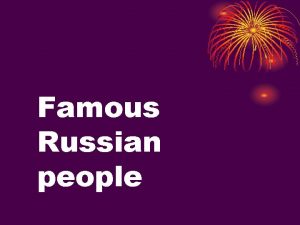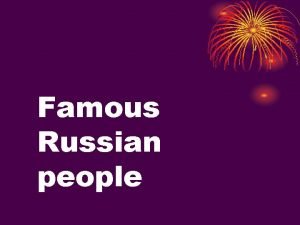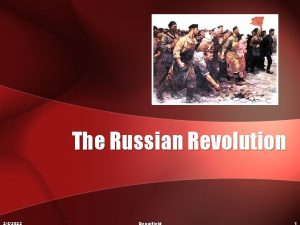The Russian Revolution Why would people want to
















































- Slides: 48

The Russian Revolution

Why would people want to rebel against their government?

What was the Russian Revolution? The revolution in the Russian empire in 1917, in which the Russian monarchy (Czarist regime) was overthrown resulting in the formation of the world’s first communist government.

Russia’ Romanov dynasty had lasted 300 years but Nicholas II, who ascended the throne in 1894, turned out to be the last Czar of Russia. How did such an ancient monarchy fall so quickly in 1917?

Rewind -1905

Russia’s Social Structure 1905

Czar Nicholas II Russia's Autocratic Government • • The Last Czar of Russia Descendant of the Russian Romanovs. Absolute ruler with unlimited powers-Ruled alone and unquestioned. Weak personality. Ignored the needs of his people. Czarina Alexandra, wife of Nicholas II was German.


The People • Majority of the Russians were peasants or factory workers. • Most peasants did not own the land they farmed. • Factory workers had to endure long hours, low pay, and horrible working conditions. • About 80% of Russians were poor.

ECONOMY • Economy was based on agriculture. • Russia was not as industrialized as the rest of Europe. • Russia’s war with Japan had devastated Russia’s economy. • Food prices went up, but the wages remained the same. • Many people were starving.

Bloody Sunday The Path to the Revolution

1905 BLOODY SUNDAY –What happened? Sunday, 22 nd January, 1905 On a Sunday afternoon, a large group of over 200, 000 unarmed workers, their families, and supporters along with Father Gapon, a Russian priest led a peaceful demonstration in St. Petersburg. • Demonstrators wanted to present a petition to the Czar regarding better working conditions, more wages, and freedom. • The unarmed demonstrators were shot by the Czar's troops. Many innocent people were killed.


• Bloody Sunday sparked several protests and strikes by the Russian people. • The Czar was forced to create the Duma-the Russian Parliament. • Nothing really changed, Nicholas kept power and if members of the Duma disagreed with the Czar they were

Fast forward to 1917…

WWI (What another War!) The First World War proved to be the last straw for the Czar’s government. • Millions of Russian troops were getting killed. • Soldiers were not well prepared with proper weapons, or supplies. • . Nicholas left the government in the hands of his wife, the Czarina,

RASPUTIN

Overview of Causes Economic differences between social classes. Russo-Japanese War Bloody Sunday, the massacre of unarmed protestors outside the palace in 1905. Weak leadership of Czar Nicholas II . Devastation of World War I—high casualties, economic ruin. Food shortages, widespread hunger low wages, landless peasants. Rasputin

Russia’s Social Structure in 1917 Did anything change?

1917 The Revolutions

Two Revolutions In One February 1917 Revolution October 1917 Revolution THE END OF RUSSIAN AUTOCRACY THE RISE OF COMMUNISM o Three centuries of Romanov Dynastic rule comes to an end. Czar Nicholas II abdicates his throne. Lenin leads the Bolsheviks to power.

The February Revolution • On February 28, 1917, Czar Nicholas is forced to abdicate (give up) the throne. • A provisional (temporary) government takes over. • THE PROBLEM: • Provisional government supports the war. • Peasants are still without land.

The October Revolution “Peac e, Lan d, Bread !” “All p ower to the S oviets !” • Bolsheviks gain support from peasants with promise of land. • Led by Lenin with slogans such as “Peace, Land, Bread!”, the Bolsheviks take over the provisional government. The Bolshevik Party will be later

What does Lenin do when he comes to power?

Lenin redistributes land to the peasants. Where did Lenin get the land from?

In 1918, Lenin officially pulls Russia out of WWI. Note: Russia stopped fighting in 1917

In 1918 Bolsheviks order the deaths of Nicholas II and his family.



To sum it up… Russia shifts from the rule of one (Czarist Regime) to a rule of a few (Bolsheviks).

RISE OF COMMUNISM


WHAT IS COMMUNISM ? • Communism is theory that all people should be equal and there should be no classes. Everyone should work for the good of the country and wealth would be equally shared amongst all citizens.

1923 CIVIL WAR In the following years after the two revolutions, the Bolsheviks or the ‘Reds’ defeat the Mensheviks or the ‘Whites’ in a civil war. By 1923 all areas of Russia came under communist control and is renamed the Union of Soviet Socialist Republics (USSR).

In 1926, a few years after the death of Lenin the country comes under the control of dictator Joseph Stalin.

In the years to come, the USSR under Joseph Stalin emerges as the world’s leading superpower.

PAUSE We have to head back to central Europe…something horrific is brewing in Germany.

LEARNING CHECK

1) A major cause of the Russian Revolution of 1917 was the A. German defeat in WWI. B. marriage of Czar Nicholas II to a German princess. C. existence of sharp economic differences between social classes. D. Russian victory in the Russo-Japanese War.

Read the statements in the box, and then answer the next question. • • Led the Russians in a second revolution (1917) • • Promised “Peace, Land, and Bread” • • Redistributed land to the peasants. 2) Which leader is being described by these statements? A. Czar Nicholas II B. Vladimir I. Lenin C. Nikita Khrushchev D. Mikhail Gorbachev

Read the statements in the box and answer the next question. • “Czar Abdicates! Provisional Government Formed” • “Peasants Promised ‘Peace, Land, and Bread’” 3) Which event is the focus of these headlines? A. Bloody Sunday B. October Revolution C. February Revolution D. Both B and C.

4) In the view of this cartoonist, Russia under Lenin’s rule was characterized by A. a continuation of traditional life B. the introduction of capitalism C. support for a constitutional monarchy D. rejection of the czarist system

5) Which statement best describes the relationship between World War I and the Russian Revolution? A. World War I created conditions within Russia that helped trigger a revolution B. World War I postponed the Russian Revolution by restoring confidence in the Czar C. the Russian Revolution inspired the Russian people to win World War I D. World War I gave the Czar’s army the needed experience to suppress the Russian Revolution

6) Revolutionary supporters of Lenin were known as_____ • A) the Bolsheviks • B) the Duma • C) the Cheka • D) the Whites

7) The Russian Parliament established after the 1905 Revolution which was given no real power to challenge the czar was known as _____. A. the Duma B. the Winter Palace C. the House of Windsor D. Petrograd

8) Mysterious advisor who used his influence over the czar and czarina to gain power and control the Russian autocracy was _______. A. Nicholas II B. Lenin C. Stalin D. Rasputin

9) Humiliating war in 1905 in which Russia lost to an Asian Imperial Power was the ______ A. B. C. D. WWI Russo-Japanese War WWII Bloody Sunday

10) A march in 1905 that led to the death of hundreds of Russians protesting poverty, poor working conditions, and starvation. A. B. C. D. October Revolution February Revolution Bloody Monday Bloody Sunday
 Russian revolution vs french revolution
Russian revolution vs french revolution Would like would rather
Would like would rather Della robbia blue streetcar named desire
Della robbia blue streetcar named desire Hey hey bye bye
Hey hey bye bye Would prefer
Would prefer World war 1 and the russian revolution chapter 27
World war 1 and the russian revolution chapter 27 Chapter 14 lesson 3 the russian revolution
Chapter 14 lesson 3 the russian revolution Causes and effects of the russian revolution
Causes and effects of the russian revolution Who lost territory after ww1
Who lost territory after ww1 Russia after ww1
Russia after ww1 Duma definition ap world history
Duma definition ap world history Russian revolution political cartoon
Russian revolution political cartoon Fever model of a revolution
Fever model of a revolution Chapter 30 revolution and nationalism worksheet answers
Chapter 30 revolution and nationalism worksheet answers Chapter 14 world war 1 and the russian revolution
Chapter 14 world war 1 and the russian revolution Effect of russian revolution
Effect of russian revolution Http://www.history.com/topics/russian-revolution
Http://www.history.com/topics/russian-revolution Russian revolution of 1905 definition ap world history
Russian revolution of 1905 definition ap world history The russian revolution
The russian revolution Triple alliance ap euro
Triple alliance ap euro How is animal farm a satire on the russian revolution
How is animal farm a satire on the russian revolution The russian revolution
The russian revolution The russian revolution
The russian revolution Russian revolution
Russian revolution The russian revolution
The russian revolution Introduction of russian revolution
Introduction of russian revolution Russian revolution effects
Russian revolution effects Causes of the russian revolution
Causes of the russian revolution Russian revolution
Russian revolution Russian revolution guided notes
Russian revolution guided notes How many people speak russian
How many people speak russian Economic causes of french revolution
Economic causes of french revolution Third agricultural revolution definition
Third agricultural revolution definition Dont ask
Dont ask Plot diagram for the outsiders
Plot diagram for the outsiders Percy jackson and the lightning thief chapter 12
Percy jackson and the lightning thief chapter 12 Why is brutus anxious for the battle to begin?
Why is brutus anxious for the battle to begin? Why do you want to work for us
Why do you want to work for us What deal is napoleon contemplating
What deal is napoleon contemplating Sudantenland
Sudantenland Tsotsi chapter 3 summary
Tsotsi chapter 3 summary Allusions in the hunger games
Allusions in the hunger games Josette dugas war of 1812
Josette dugas war of 1812 I want a wife essay
I want a wife essay Emma lazarus quote
Emma lazarus quote Why do atoms want to bond
Why do atoms want to bond Why singapore separated from malaysia
Why singapore separated from malaysia Of mice and men--study questions answers chapter 3
Of mice and men--study questions answers chapter 3 Macbeth summary act 3 scene 1
Macbeth summary act 3 scene 1




